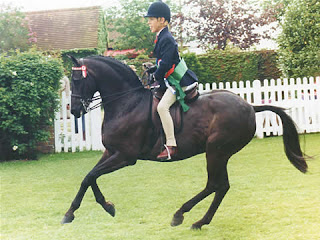
Well, the British Horse of the Year Show kicked off at the NEC Arena in Birmingham today. This event, which will be held from 7-11 October this year, is what all showies in the UK aim to qualify for. Even picking up a HOYS ticket is tough- the county shows which hold qualifying classes attract huge numbers of competitors and you often have to beat 30-40 other combinations to qualify. The horses and ponies that win at HOYS are truly the cream of the crop. I will keep this blog up to date with results as and when I receive them.
Show Hunter Of The Year Championship
Champion - Finn McCool III (Guy Landau)
Reserve - Pride & Joy (Robert Walker)
Class 26a - Lightweight Show Hunter Of The Year
1st & Ch - Finn McCool (Guy Landau)
2nd - Suppose So (Robert Walker)
3rd - Shannon Beau (Lorraine Homer)
4th - Sutton Place (Charles Le Moignan)
5th - Azarax (Katie Jerram)
6th - Agherlows Sir Walter (Magnus Nicholson)
7th - Cracker (Louise Bell)
8th - Bryon Lodge (Lyndsey Kelbie)
9th - Jazz Band (Sue Simpson)
Class 26b - Middleweight Show Hunter Of The Year
1st & Res - Pride & Joy (Robert Walker)
2nd - Standing Ovation (Jayne Webber)
3rd - Lord Litchfiield (Justine Armstrong-Small)
4th - Magnifire (Sam Kitson)
5th - District Court (Kirstine Douglas)
6th - Woodfield Indo (Katie Jerram)
7th - Foxtrot Du Mesnil (Peter Bridle)
8th - The Star (Vanessa Ramm)
9th - Royal Hero (Leon King)
Class 26c - Heavyweight Show Hunter Of The Year (top 9)
1st - Loughkeen Dancing Lord (Robert Oliver)
2nd - Book Of Kells (David Tatlow)
3rd - Manton II (Robert Walker)
4th - Foxcourt All Talk (Jo Jenkins)
5th - Cabra West (Rory Gilsenan)
6th - Avalanche II (Kevin O'Connell)
7th - Mr Gibson (Sarah Jones)
8th - The Fieldmaster II (Irene Susca)
9th - Grand Tavern (Sam Kitson)
Class 28a New Forest & Connemara M&M Pony of the Year
1st) Lecarrow King (Sam Roberts)
2nd) Knockanroe Champ (Rosie Bloor)
3rd) Skellorn Harrison (Stuart Mason)
4th) Rebel's Ghost (Emma James)
5th) Mosstown Windy (Jessica Major)
6th) John's Cuckoo (Matthew Lawrence)
7th) Kingstown Barney (Alex Humble)
8th) Rosenanharley Ban Rion Laura (Jemma James)
9th) Misty Blue (Leanne Goodwin)
Runners up (final 11)- Loughfadda Best Man (Charlotte Band) and Oasklands Donatello (Stephanie Averis)
Class 28b Fell, Highland & Dales M&M Pony of the Year
1st) Dunedin Marksman (Matthew Lawrence)
2nd) Xander of Mendick (Georgina Burton)
3rd) Castle Hill Raven (Hayley Marie Reynolds)
4th) Thornville Jake (Michelle Offen)
5th) Waterside Ben II (Tracey Milward)
6th) Kilmannan Black Magic (Richard Telford)
7th) Kilmannan Black Wizard (Victoria Hesford)
8th) Darrenvale Warrior (Charlene Richardson)
9th) Sunglow Lady Paula (Sam Roberts)
Runners up (final 11)- Faradale Barney (Sarah Pinfield) and Kilmannan Black Velvet (Henry Hird)
Class 31a - SEIB Search For A Star Cobs (similar to NZ Rising Stars)
1st - Chinwaggfinn
2nd - Hot Property II
3rd - Traffic Cob
4th - Weeden's Earl Grey
5th - Rose Of Leamlara
Pull-In Order:
1 - Chinwaggfinn
2 - Hot Property
3 - Donny Brook
4 - Traffic Cob
5 - Weeden's Earl Grey
6 - Miss PartyPants
7 - Rose Of Leamlara
8 - Finius Fog
9 - Ardenteggle Boy
10 - Fergus IV
Class 31b - SEIB Search For A Star Riding Club Show Horse
1st - Innish Verdel
2nd - Mr Mick
3rd - Lambrigg Spotlight
4th - Glenavy
5th - All That Jazz
(Retired - Indian Opposition - pulled first but didn't stand for presentation)
Pull-In Order:
1 - Mr Mick
2 - Mister Julius
3 - Indian Opposition
4 - Glenavy
5 - Sandro Isabella
6 - All That Jazz
7 - Innish Verdel
8 - Clogherboy Lucky Boy
9 - Daid O'Diamonds
10 - Lambrigg Spotlight
Class 29a - Stallions Miniature Horse Of The Year
1st & Champion - MHB Apollo
2nd - Dukes Country Colours
3rd - Spotlights Rough Diamond
4th - LTDS Wildcard
5th - Dukes Twist Of Colours(Placed to fifth)
Class 29b - Mares/Geldings Miniature Horse Of The Year
1st & Reserve - Scott Creek My Key To Fashion
2nd - Strike A Little Star
3rd - Alamos Daisy
4th - Lewingales Electra
5th - Conundrum La Bella Milan
Class 29c - Youngstock Miniature Horse Of The Year
1st - Dayhill Travelling Technicolour
2nd - Hailstone Ready To Rumble
3rd - Ujenik Bantam's Little Princess
4th - Scott Creek Call Girl Dot Com
5th - Aesthete Lavender BlueChampionship
Champion MHB Apollo, Reserve Scott Creek My Key To Fashion
































